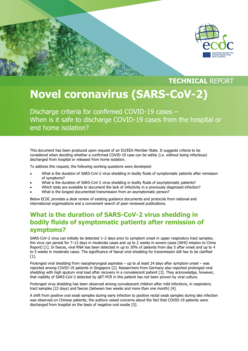Hello! You're looking at a policy document report on Overton
We track government policy, guidelines, think tank research, working papers and more to help our customers see the impact and influence of their work. Are you interested in seeing what information we have to offer? Request a free trial to our platform.
If you fund, produce or manage research or work to influence policy, we'd love to talk. Learn more on our homepage.

Novel coronavirus (SARS-CoV-2) - Discharge criteria for confirmed COVID-19 cases
This document suggests criteria to be considered when deciding whether a confirmed COVID-19 case can be safely (i.e. without being infectious) discharged from hospital or released from home isolation.
Topics in this document
Immunology
Health care
Microbiology
Infectious diseases
Epidemiology
Medicine
Diseases and disorders
Medical specialties
Clinical medicine
Health sciences
Health
Coronavirus disease 2019
Severe acute respiratory syndrome coronavirus 2
Severe acute respiratory syndrome
Public health
Infection
Virus
Life sciences
Transmission (medicine)
Symptom
Clinical pathology
Influenza
Biology
Related SDGs
SDG 3: Good Health and Well-being ...
SDG 3: Good Health and Well-being
Target 3.3
End the epidemics of AIDS, tuberculosis, malaria and neglected tropical diseases and combat hepatitis, water-borne diseases and other communicable diseases
Target 3.d
Strengthen the capacity of all countries, in particular developing countries, for early warning, risk reduction and management of national and global health risk
Cites research funded by
1
Ministry of Science and Technology of the People's Republic of China
1
National Natural Science Foundation of China
1
Youth Innovation Promotion Association of the Chinese Academy of Sciences
1
National High-tech Research and Development Program
1
National Science and Technology Major Project of China
Citations
Cited by 56
other policy documents
(48 of them are from other policy sources)
